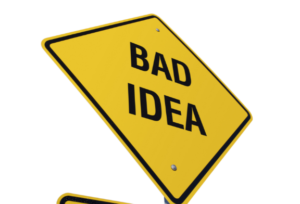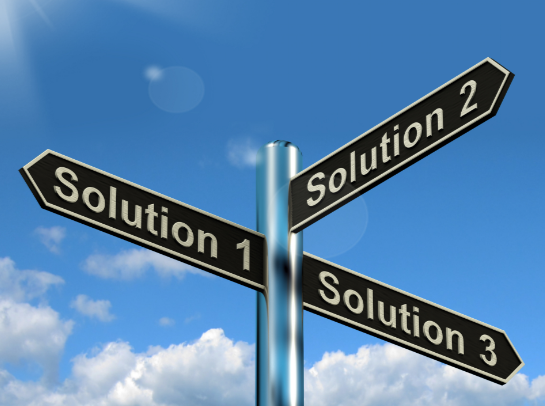We live in an unprecedented age of information, and that leads to almost infinite options. Cars, phones, jobs, products, and lifestyle options result in unparalleled difficulty in decision-making effectiveness. And common biases will destroy decision-making results.

When you change the way you look at things, the things you look at change.
– Wayne Dyer
Decisions are complex and lead to difficulty because they represent sacrifices of choice. Choosing something inherently means giving up something else. It is all about preference. And the underbelly of preference biases.
Related post: 13 Requirements to Improve Business Performance
What is Bias?
Bias, according to Merriam-Webster, is either “an inclination of temperament or outlook; especially: a personal and sometimes unreasoned judgment.”
Some biases are conscious. For example, I prefer dogs over cats — I think dogs are friendlier, more lovable, and less likely to scratch me. But I don’t know why I prefer the color blue over the color red — I have an unconscious, also known as implicit, bias.
Bias doesn’t just refer to a belief or judgment about a particular thing (i.e. that I like dogs better than cats). In psychology, “bias” also refers to behavioral tendencies that affect how we reach conclusions and ultimately make decisions.
Why Does Bias Matter?
Some biases are conscious. For example, I prefer dogs over cats — I think dogs are friendlier, more lovable, and less likely to scratch me. But I don’t know why I prefer the color blue over the color red — I have an unconscious, also known as implicit, bias.
Implicit bias is everywhere, and it affects the way we act and treat other people — sometimes to alarming results.
Related: The Story and Zen of Getting Things Done
They cause us to make snap judgments based on bad information, to be unfair, and to waste time. This is clearly problematic for investors, managers, and people in general. Once we become aware of these biases, we can more quickly come to terms with reality and consequently make better decisions.
We all view the world through different lenses. This has to do with our upbringing, our collective experiences, and our subconscious behavioral biases. Until we take a deep look into why we see the world the way we do, we’ll never have the capacity for real change and improve the effectiveness of our decision-making.
Here are some behavioral biases from the Singularity Institute, Tim Richard’s Psy-Fi Blog, and more, to bring these biases to light so we can become more aware of their influence and impact on us.
Regardless, I think it’s fascinating to learn more about how we think and make decisions every day, so let’s take a look at some of these behavioral biases we didn’t know we were relying on for our decisions.

Over worrying
Often, despite how much we pay attention to the sunk cost fallacy, we still naturally gravitate toward it.
The term sunk cost refers to any damage, including monetary, time, and effort, which has been paid already and cannot be recovered. Gone forever.
The tendency is to put more emphasis on negative experiences rather than positive ones. People with this bias feel that “bad is stronger than good” and will perceive threats more than opportunities in a given situation.
This leads to loss aversion.
The reason we can’t ignore the loss, even though it’s already been paid, is that we are wired to feel loss far more strongly than gain. Psychologist Daniel Kahneman explains this in his book, Thinking Fast and Slow:
Organisms that placed more urgency on avoiding threats than they did on maximizing opportunities were more likely to pass on their genes. So, over time, the prospect of losses has become a more potent motivator in your behavior than the promise of gains.
The sunk cost fallacy plays on this tendency of ours to emphasize loss over gain.
Being such a subconscious reaction, it’s hard to avoid this. Our best bet is to try to separate the current facts we have from anything that happened in the past

Framing effect bias
The manner in which choices are presented to us also affects how we view them. A study had participants watch a traffic accident and asked: “About how fast were the cars going when they contacted each other?”
The researchers then replaced the verb “contacted” with “hit,” “bumped,” “collided,” and “smashed” for different groups of participants. As the intensity of the action verb increased, so did the participants’ speed estimates. They guessed that the cars were going 31, 34, 38, 39, and 41 miles per hour, respectively.
Destroy decision making … zero-risk bias
The preference in this bias is to reduce a small risk to zero versus achieving a greater reduction in an increased risk.
This plays to our desire to have complete control over a single, more minor outcome, over the desire for more — but not complete — control over a greater, more unpredictable outcome.
Use information that matches beliefs
We tend to like people who think like us. If we agree with someone’s beliefs, we’re more likely to be friends with them.
While this makes sense, it means that we subconsciously begin to ignore or dismiss anything that threatens our worldviews, since we surround ourselves with people and information that confirm what we already think.
This is called confirmation bias.
If you’ve ever heard of the frequency illusion, this is very similar. The frequency illusion occurs when you buy a new car, and suddenly you see the same car everywhere. Or when a pregnant woman suddenly notices other expectant mothers all over the place.
It’s a passive experience, where our brains seek out information that’s related to us, but we believe there’s been an actual increase in the frequency of those occurrences.
Confirmation bias is a more active form of the same experience. It happens when we proactively seek out information that confirms our existing beliefs.
The librarian group remembered Jane as being introverted and later said that she would not be suited to a real-estate job. The real-estate group did the exact opposite: they remembered Jane as extroverted, said she would be suited to a real-estate job, and when they were later asked if she would make a good librarian, they said no.
The “swimmer’s body” illusion
This is one of my favorite behavioral biases. In Rolf Dobelli’s book, The Art of Thinking Clearly, he explains how our ideas about talent and extensive training are often well off-track.
Professional swimmers don’t have perfect bodies because they train extensively. Rather, they are good swimmers because of their physiques. How their bodies are designed is a factor for selection and not the result of their activities.
The “swimmer’s body illusion” occurs when we confuse selection factors with results.
Another good example is top-performing universities: are they the best schools, or do they choose the best students, who do well regardless of the school’s influence?
Attentional bias occurs when someone focuses on only one or two choices despite there being several possible outcomes. It is the tendency of our perception to be affected by our recurring thoughts. For example, people who frequently think about the clothes they wear pay more attention to the clothes of others.
The anchoring effect
This bias is the tendency to rely too heavily on one piece of information. For example, when buying a used car, someone might focus too much on the odometer reading, rather than considering engine condition and other factors. During decision-making, anchoring occurs when individuals use an initial piece of information to make subsequent judgments.
Related post: 6 Ways Biases Destroy Decision-Making Results
Dan Ariely is a behavioral economist who gave one of my favorite TED talks ever about the irrationality of the human brain when it comes to making decisions.
He illustrates this particular mistake in our thinking superbly, with multiple examples. The anchoring effect essentially works like this: rather than making a decision based on pure value for investment (time, money, etc.), we factor in comparative value—that is, how much value an option offers when compared to another option.
The bottom line
The reason we make decisions that are not always rational is that they can’t be isolated from who we are, where we are, or what made us decide.
But by being aware of the psychological factors that affect our choices — and recognizing how decisions are interrelated, we’ll be able to not only make better decisions for ourselves but help others do the same.

So what’s the conclusion? The conclusion is there is no conclusion. There is only the next step. And that next step is entirely up to you.
It’s up to you to keep improving your continuous learning. Lessons are all around you. In many situations, your competitor may be providing the ideas and or inspiration. But the key is in knowing that it is within you already.
All you get is what you bring to the fight. And that struggle gets better every day you learn and apply new lessons.
When things go wrong, what’s most important is your next step.
Test. Learn. Improve. Repeat.
Are you devoting enough energy to improving your continuous learning for yourself and your team?
Do you have a lesson about making your lifelong learning better you can share with this community? Have any questions or comments to add in the section below?
Mike Schoultz is the founder of Digital Spark Marketing, a digital marketing and customer service agency. With 40 years of business experience, he blogs on topics that relate to improving the performance of your business. Find them on G+, Twitter, and LinkedIn.
Digital Spark Marketing will stretch your thinking and your ability to adapt to change. We also provide some fun and inspiration along the way. Call us for a free quote today. You will be amazed at how reasonable we will be.
More reading on business challenges from Digital Spark Marketing’s Library:
Adaptation … 5 Awesome Business Examples for Study
9 Secrets to the Chipotle Culture and Employee Engagement Success
How to Change the World … 9 Amazing Ways
Like this short blog? Follow Digital Spark Marketing on LinkedIn or add us to your circles for 3-4 short, interesting blogs, and stories per week.
